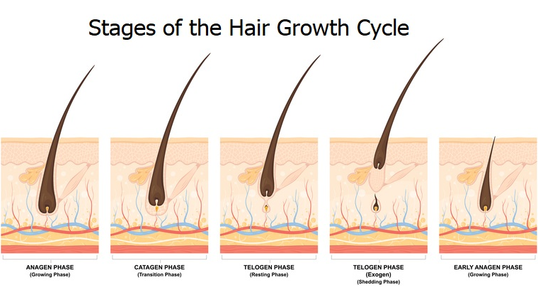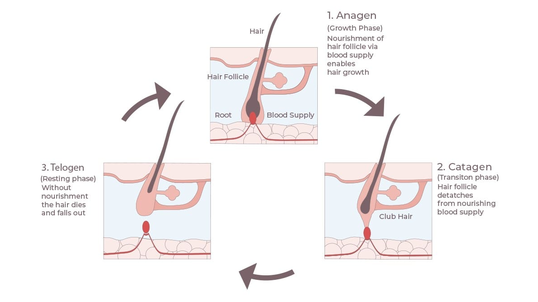Hair Growth Cycle
Hair Growth Cycle
How Does Hair Grow? There are around 100,000 hair follicles on the scalp alone, and about five million hair follicles on the body. Hair is made up of two main parts: the follicle and the shaft. The shaft grows from the follicle, which is the root of the hair located beneath the skin. The hair follicle itself is made up of the derma papilla and the bulb. The dermal papilla contains tiny blood vessels that deliver blood supply to the hair follicle. The dermal papilla nourishes the hair follicle with the necessary nutrients for hair growth. The bulb, which surrounds the papilla, is where the hairs’ cells divide. The hair shaft is the visible part of the hair. The hair shaft is made up of a hard protein called keratin and a scale-like outer protective layer called the cuticle. Hair shafts are actually dead, which is why it doesn’t hurt to get a haircut. Understanding the Hair Growth Cycle As new hair is manufactured in the follicle, it pushes out the hair shaft, creating longer hair. Hair grows about 0.3 mm to 0.4 mm each day or about 1 cm average a month in the anagen (growing) phase. However, not all of the hair follicles are growing new hair at the same time. Hair growth occurs in a cycle. At any given time, each strand is in a different part of the cycle. It’s a good thing that each hair strand is not in synchronized cycle, otherwise we would shed all of our hair at the same time. The Phases of the Hair Growth Cycle The hair cycle is made up of four phases: the Anagen (Growing) phase, the Catagen (Transition) phase, the Telogen (Resting) phase and the Exogen (Hair Shedding) phase. 1) Anagen (Growing) Phase Hair growth begins with the anagen phase. The healthier the scalp hair is, the longer the lifespan of the hair or the duration of anagen. The anagen phase also differs with different types of hairs. The anagen phase of a terminal hair on the scalp can last between 2 to 5 years on average, sometimes up to 7 years whereas the anagen phase of a vellus hair or thinning (miniaturised) hair last probably several months. The anagen phase for eyebrow and body hairs is also much shorter than that of the scalp hair. At any time, a person with a healthy scalp has about 90% of the hair in anagen phase whereas that anagen percentage can fall to 80% or even lower for a person suffering from hair loss. 2) Catagen (Transition) Phase The catagen phase starts when the anagen phase ends and lasts around two to three weeks. In this transitional phase, hair stops growing and detaches itself from the blood supply and is then named a club hair. About 3% to 5% of the scalp hair is in catagen phase. 3) Telogen (Resting) Phase The telogen phase is the resting phase which lasts around three months. In the resting phase, the club hairs rest in the root while new hair begins to grow beneath it. An estimated 10% to 15% of the scalp hairs are in this phase. 4) Exogen (Hair Shedding) Phase The exogen phase is essentially an extension or a part of the telogen stage of hair growth. During the exogen phase, hair is shed from the scalp, often helped along by washing and brushing. Shedding 50 to 100 hairs per day during the exogen phase is normal. The new hairs can take around 2 to 5 months to grow to a visible length to replace the old hairs that shed.


Get special discounts and offers
Join our newsletter and be the first to know